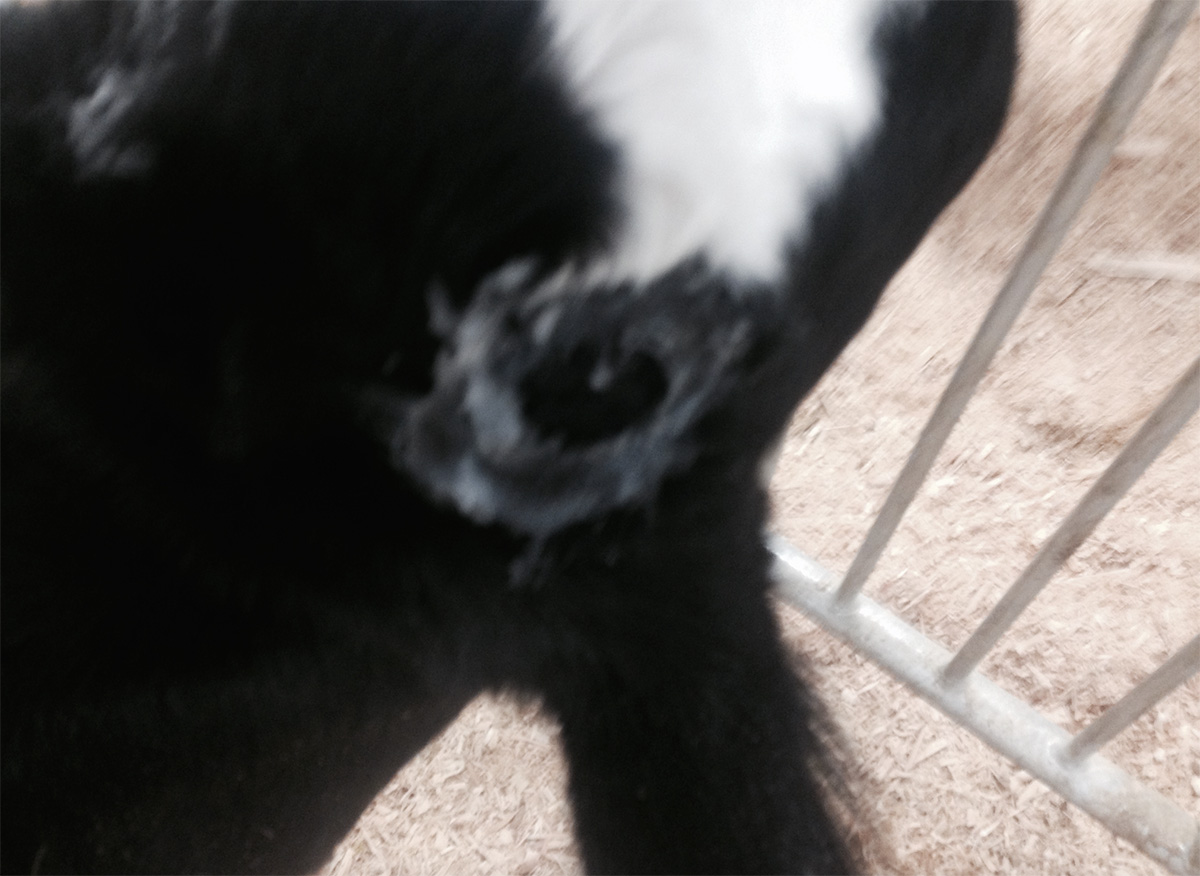- Step 1: Restraining the Calf
- Step 2: Sedating the Calf [Optional]
- Step 3: Draw up Lidocaine
- Step 4: Locate the Injection Site
- Step 5: Administer the Nerve Block
- Step 6: Wait 5 Minutes
- Step 7: Begin Disbudding
- Step 8: Apply Antibacterial Product
- Step 9: Clean Up
STEP 1: RESTRAINING THE CALF
- Catch the calves with a calf halter and tie them to something secure.
- Never leave tied calves unsupervised!
- Proper restraint is necessary to ensure the safety of both yourself and the calves. Calves should be tied tight enough that you can control the calf’s movements but preferably in a way that allows you to still have access to both horns.
1.1 SEDATION?
- Sedating calves makes handling a lot easier during the disbudding process however, it does not replace the administration of a local nerve block! Local anesthetic and an NSAID are still essential for pain control, even in sedated calves.
1.2 GOOD RESTRAINT TECHNIQUES
- Tie the calf to something secure in a way that limits their movement but without causing unnecessary distress. Calves who are not used to being tied will struggle against the restraint even when tied correctly, as shown in the video below.
In the video, the calf is tied too loose, and it may be difficult to control the calf’s movements.
1.3 TYING THE CALF'S HEAD TO THE SIDE
- If you have a pen, you can use this to your advantage by pulling their head through the windows and tying it to the side. It is often easier to tie the calf’s head to one side (allowing access to one horn bud) then untie and tie to other side as needed, as shown below.
STEP 2: SEDATING THE CALF
*Optional
- If you wish to sedate your calves, do so now before to administer the nerve block. If you do not wish to sedate your calves, proceed to the next step.
- Sedated calves are much easier to handle but it also requires extra caution.
- Sedation can be mild or heavy sedation – speak wth your veterinarian to see what is appropriate for your farm. Sedation does not replace pain control – both local anesthetic and an NSAID are still needed.
2.1 DEGREES OF SEDATION AND THEIR BENEFITS
MILD SEDATIVE BENEFITS:
- Calf is still standing but will struggle less during the injection of the local pain block and even less during the disbudding process.
- Calf may fall down during the disbudding process; will be unstable standing up.
- Need to supervise calves until they fully awake from the sedation.
HEAVY SEDATIVE BENEFITS:
- Calf is laying down (minimal to no struggling).
- Not going to fall down.
- May be difficult to access both sides of the calf’s head depending on how they are lying down.
- Takes longer for calves to awake from sedation (longer supervision time).
- WARNING
- Never leave sedated calves unattended.
- Sedated calves are much easier to handle but it also requires extraDo not mix sedated and non-sedated calves in the same pen. caution.
- Make sure calves are in a clean and dry pen.
- Sedating a calf does not replace administering a nerve block and NSAID.
STEP 3: draw up lidocaine
Fill your 12 mL syringe with 10 mL of lidocaine. Remember to use a clean needle in the bottle and add a new needle to the syringe for each calf.
STEP 4: LOCATE THE INJECTION SITE
Start by locating the horn bud. Run your hand down the side of the calf’s face towards the outer corner of the eye; you should feel a ridge. The injection site is located just below the ridge where it ends at the outer corner of the eye (red dot). You can feel a slight depression. See videos below for reference.
4.1 LOCATION OF THE HORN BUDS
- Feel the top of the calf’s head for the horn buds located on either side of the poll as shown in the picture and video below.
- Their size will vary depending on the calf’s age.
Quick Tip
Clipping the hair around the horn buds can make it easier to visualize them; especially on younger calves.
STEP 5: ADMINISTER THE NERVE BLOCK
5.1 Insert needle at the injection site
- Angle needle towards the middle of the calf’s head between the eyes.
- Insert the full length of the needle (to the hub of the needle).
Quick Tip: Angle of the Needle
When inserted, the needle will be angled towards the middle of the calf’s head, between the eyes, as shown in the video and pictures below.
5.2 Inject AT THE INJECTION SITE
-
Step 1
Inject 1.5 mL of lidocaine.
-
Step 2
Pull the needle out slightly, redirect the needle and inject another 1.5 mL.
-
Step 3
Redirect the needle once more and inject a bit more lidocaine (~1 mL).
-
Step 4
As you pull the needle out, inject another 1 mL. You should have injected a total of 5 mL.
-
Step 5
Rub the injection site after removing the needle; then, repeat on the other side of the calf's head.
Observe the videos below for reference.
What do I do if I hit something hard when inserting the needle?
Don’t worry, this simply means that you have hit bone. Just pull the needle out slightly, redirect it and try inserting it further.
What do I do if I draw blood when I pull back on the syringe?
Pull the needle out slightly, redirect and try again until you do not draw blood.
If blood is drawn during injection, you should always get a new syringe (and needle) before proceeding to the next calf. *18- (or 20-) gauge needle x 1.5″.
Key things to remember when administering the nerve block:
- To find the injection site, start at the horn bud and follow the ridge along the side of the of the face to the corner of the eye.
- Angle the needle towards the middle of the calf’s head between the eyes.
- Always pull back on the syringe before injecting.
- Inject a total of 5 mL per horn (on each side) but remember to redirect the needle 3x and inject a bit as you pull the needle out.
- Rub the injection site after you are done.
- Wait at least 5 minutes for the nerve block to take effect.
- Always use a new needle for each calf.
STEP 6: WAIT 5 MINUTES
6.1 WHILE YOU ARE WAITING
- Administer the nerve block to the other calves,
- Clip the hair around the horn buds,
- Administer Metacam (or other NSAID),
- Common practice to check for extra supramammary teats at time of dehorning.
6.2 WAS MY NERVE BLOCK SUCCESSFUL?
- If your nerve block was successful the calf should not overly react when you place the disbudding iron against their head.
- If there is a significant reaction by the calf then your nerve block was not successful.
- If the calf did not react at the initial contact but starts bucking or moving around afterwards, the nerve block was most likely successful; the calf is just resisting being restrained.
6.3 clipping hair around the horn buds
Administer NSAID according to label directions or your veterinary prescription.
STEP 7: begin disbudding
7.1 caustic paste disbudding
-
Step 1
Restrain the calf and ensure you can see and feel the horn bud.
-
Step 2
Wear gloves! Caustic paste will burn your skin.
-
Step 3
Apply a ring of petroleum jelly around the horn bud, to help make sure the paste doesn’t run or drip.

-
Step 4
Apply a thin layer of paste to the horn bud (for most calves, a dime-sized amount is sufficient). If using a tub of paste, you can do this with a gloved finger, or with a popsicle stick.
-
Step 5
If paste gets on your hands or other parts of the calf besides the horn bud, flush the area with vinegar to neutralize the paste.
-
Step 6
Check calves 30 to 60 minutes after paste application to ensure paste hasn’t been rubbed onto other parts of the body or in their eyes. By using the never block ahead of applying the paste, you will help reduce the chance calves will rub their horn buds, since they will not be feeling any discomfort!
7.2 CAUTERY (IRON) DISBUDDING
-
Step 1
Get a strong hold of the calf’s head and feel for the horn bud.
-
Step 2
Apply the tip of the disbudding iron over the horn bud; keeping it perpendicular to the calf’s skull
-
Step 3
Apply firm and even pressure for approximately 10 seconds.
-
Step 4
During the last 5 seconds provide a slight rotating motion.
-
Step 5
Use the tip of the disbudding iron to remove the cauterized tissue; you should see a white circle underneath (totally normal).
What do I do if the nerve block was unsuccessful?
Re-administer the nerve block, wait 10 minutes then try to disbud again.
What do I do if the What do I do if the wound starts to bleed?
Use the hot iron to cauterize the wound and stop the bleeding.
7.3 IF YOU ARE USING A BLUNT DISBUDDING TOOL
STEP 8: apply antibacterial product
8.1 EXAMPLES
- Chlorhexidine
- Topical wound spray
- Dilute hydrogen peroxide
STEP 9: clean up
- Double check each calf to ensure there is no bleeding and disbudding occurred correctly.
- Untie the calves and remove the halters.
- Properly dispose of used needles and syringes.
